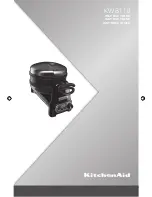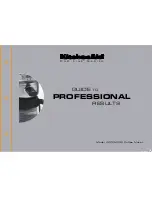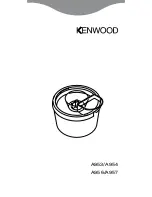
26
27
COffEE MAkING TIPS & PREPARATION
COffEE MAkING TIPS & PREPARATION
COffEE dOSE ANd TAMPING
•
Wipe filter basket with a dry cloth.
•
If using Single Wall filter baskets, grind
just enough coffee to fill the filter basket.
You may need to experiment with how
long the grinder needs to run to achieve
the correct dose.
•
Tap the portafilter several times to
distribute the coffee evenly in the
filter basket.
•
Tamp down firmly (using approx.
30-40lbs or 15-20kg of pressure). The
amount of pressure is not as important
as consistent pressure every time.
•
As a guide to dose, the top edge of the
metal cap on the tamper should be level
with the top of the filter basket after the
coffee has been tamped.
•
Wipe excess coffee from the rim of the
filter basket to ensure a proper seal in
the group head is achieved.
PURGING ThE GROUP hEAd
•
Before placing the portafilter into the
group head, run a short flow of water
through the group head by pressing
and holding the 1 CUP button. This
will purge any ground coffee residue
from the group head and stabilize the
temperature prior to extraction.
INSERTING ThE PORTAfILTER
Place the portafilter underneath the group
head so that the handle is aligned with
the INSERT position. Insert the portafilter
into the group head and rotate the handle
towards the center until resistance is felt.
EXTRACTING ESPRESSO
•
Place pre-warmed cup(s) beneath the
portafilter and press the MANUAL,
1 CUP or 2 CUP button for the
required volume.
•
As a guide, the espresso will start
to flow after 8-10 seconds (infusion
time) and should be the consistency
of dripping honey.
•
If the espresso starts to flow after less
than 6 seconds you have either under
dosed the filter basket and/or the
grind is too coarse. This is an
UNDER-EXTRACTED shot.
•
If the espresso starts to drip but doesn’t
flow after 15 seconds, then you have
either over dosed the filter basket
and/or the grind is too fine. This is an
OVER-EXTRACTED shot.
A great espresso is about achieving the
perfect balance between sweetness, acidity
and bitterness.
The flavor of your coffee will depend on
many factors, such as the type of coffee
beans, degree of roast, freshness, coarseness
or fineness of the grind, dose of ground
coffee, and tamping pressure.
Experiment by adjusting these factors
just one at a time to achieve the taste
of your preference.
TEXTURING MILk
•
Always start with fresh cold milk.
•
Fill the jug just below the “V” at the
bottom of the spout.
•
Position the steam tip above the drip tray
and lift the STEAM LEVER to purge the
steam wand of any condensed water.
•
Insert the steam tip ¼-¾" (1-2cm)
below the surface of the milk, close to
the right hand side of the jug at the
4 o’clock position.
•
Move the STEAM LEVER to the OPEN
position.
•
Keep the tip just under the surface of the
milk until the milk is spinning clockwise,
producing a vortex (whirlpool effect).
•
With the milk spinning, slowly lower the
jug. This will bring the steam tip to the
surface of the milk & start to introduce
air into the milk. You may have to gently
break the surface of the milk with the tip
to get the milk spinning fast enough.
•
Keep the tip at or slightly below the
surface, continuing to maintain the
vortex. Texture the milk until sufficient
volume is obtained.
•
Lift the jug to lower the tip beneath
the surface, but keep the vortex of milk
spinning. The milk is at the correct
temperature (140-149°F or 60-65°C)
when the jug is hot to touch.
•
Move the STEAM LEVER to the
CLOSED position BEFORE taking the
tip out of the milk.
•
Set the jug to one side, lift the STEAM
LEVER to purge out any residual milk
from the steam wand and wipe steam
wand with a damp cloth.
•
Tap the jug on the bench to collapse
any bubbles.
•
Swirl the jug to “polish” and re-integrate
the texture.
•
Pour milk directly into the espresso.
•
The key is to work quickly, before the
milk begins to separate.
hINTS & TIPS
•
Always use freshly ground coffee
for a superior flavor and body.
•
Use freshly roasted coffee beans,
with a ‘roasted on’ date and use within
2 weeks of ‘roasted on’ date.
•
Store coffee beans in a cool,
dark and dry container. Vacuum
seal if possible.
•
Buy coffee beans in small batches
to reduce the storage time and store no
more than one weeks supply at
any time.
•
Grind beans immediately before
brewing as ground coffee quickly loses
its flavor and aroma.
OPTIMUM
10g** 1 CUP
18g** 2 CUP
25-35 SEC
BALANCED
GRIND
TAMP
GRIND DOSE
SHOT TIME
TOO FINE
TOO MUCH
TOO HEAVY
OVER 40 SEC
OVER EXTRACTED
BITTER
•
ASTRINGENT
TOO COARSE
TOO LITTLE
TOO LIGHT
UNDER 20 SEC
UNDERDEVELOPED
•
SOUR
UNDER EXTRACTED
30-40lbs
(15-20kg)
EXTRACTION GUIdE
** Breville’s filter baskets have been designed for 10g/18g, a larger volume than the industry standard
of 7g/14g. Using less than 10g/18g may affect the espresso produced.















































